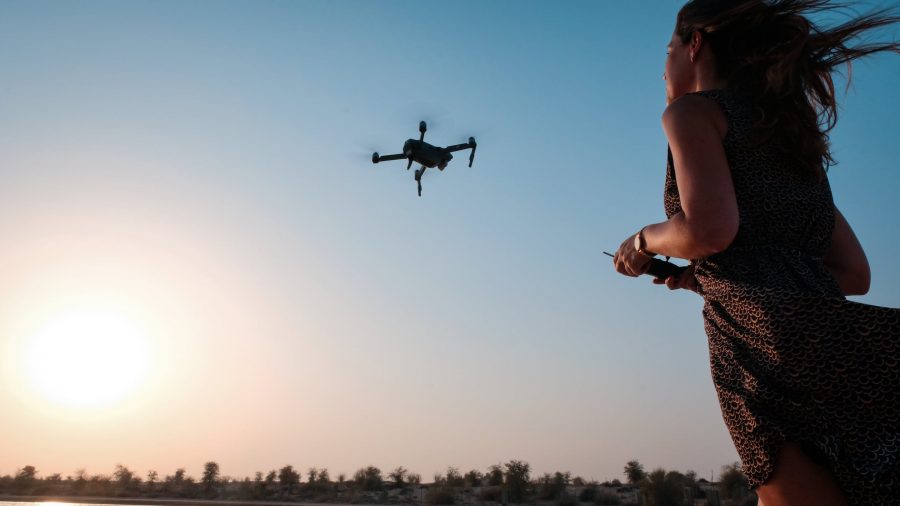Watching a top-shelf drone reduce itself from premium remote-controlled aircraft to a heap of shattered components after a single disastrous war with gravity is not entirely unlike seeing your own hard-earned cash tumble out of a tree and into a bonfire. An amateur pilot who doesn’t appoint a healthy ration of caution as his co-pilot won’t patrol the friendly skies for long. Instead, a beleaguered budget and somber shopping for a replacement will await while pondering the array of mistakes responsible for that battered, broken miracle of cutting-edge avionics looking like some graduate art student’s jagged, abstract sculpture.

Take heart. No drone flight has to descend into a nerve-wracking experience. In fact, after taking some time to internalize a few basic instructions and tips, you may feel like crashing your drone would require actual concerted effort on your part. It really can be that simple.
Keep Your First Drone Simple
For the sake of argument, let’s assume you have never flown a drone in your life. You don’t need a grand flourish of bleeding-edge technology to introduce yourself smoothly to the friendly skies. Keep that sexy, pricey model with the innovative thermal camera in perspective as a step-up purchase once you get the hang of a modestly sized, affordable bird. Crashing one can heartbreakingly set you back a month’s rent or so. A beginner-friendly drone will still allow you to hone your reaction time and flight controls at a more reasonable replacement price. Ease your way up to a more prestigious model only once you feel perfectly ready for more reactive, advanced hardware.
Start Slow
When first taking your drone out for a spin, master hovering steadily for a few seconds around 5 feet in the air. As you feel out the balance, increase another 5 feet every several seconds. This will gradually and safely ingrain the most repeatable tasks when flying a drone, as well as introducing manipulation of pitch, yaw and roll. Developing a kind of muscle memory when guiding your drone’s movement builds a solid foundation before working on positioning your camera for the most striking, smooth footage and still images with methodical, gradual motions.
Into the Great, Wide Open
Give yourself some space. Learning to fly your drone in expansive, open areas where a crash will create the least impact possible beats making clumsy mistakes around more daunting terrain. Parks and football fields should allow you to steer clear of bystanders, power lines and larger trees. Given the choice, morning flights will typically make it easier to avoid both encroaching crowds and potentially fierce winds over 15mph. Most drones hold up well enough in windy weather, the ensuing shaky footage and still likely won’t prove to be worth the effort.
Fly (Somewhat) Blind
Relying immediately on an amateur or professional-model drone with onboard GPS features may instill less than ideal habits right from the start. Although such navigation hardware can often return your craft smoothly to a designated home location or even fly unassisted, easing your learning curve risks your drone’s safety on the back of occasionally unreliable technology. Obstacles such as canyons, steep mountains and high trees can all cause a GPS system to fail as soon as they break up line of sight. Start off learning to manually navigate your drone quickly back to you before the battery expires. You may wish you had started off understanding the “hard way” to maneuver if you ever have to waste a day searching high and low across a daunting landscape for a downed device.
Pre-Launch Inspection
Before Turning Your Drone Loose, Thoroughly Examine This Preliminary Checklist:
- No people or airports within flight path
- Safe wind and weather conditions
- Freshly charged batteries
- Properly attached propellers are spinning smoothly with no obstruction
- Camera is correctly configured
- No WiFi signals crowding your flight area
- Takeoff and landing zones are level and obstacle-free
- Flight log updated with your date, time, flight path and weather conditions
Finally, familiarize yourself and abide carefully by your state and local laws regulating when, where and how drones can be flown. Remember, they exist for both your safety and that of everyone who may wander within your flight path. For example, your descending drone may create dangerous hazards if flown over airports, national parks, stadiums or large crowds of people. You must always fly strictly within line of sight and never at altitudes exceeding 400 feet. Lastly, you should always return your drone to its home with ample battery power remaining in case of an emergency.



























